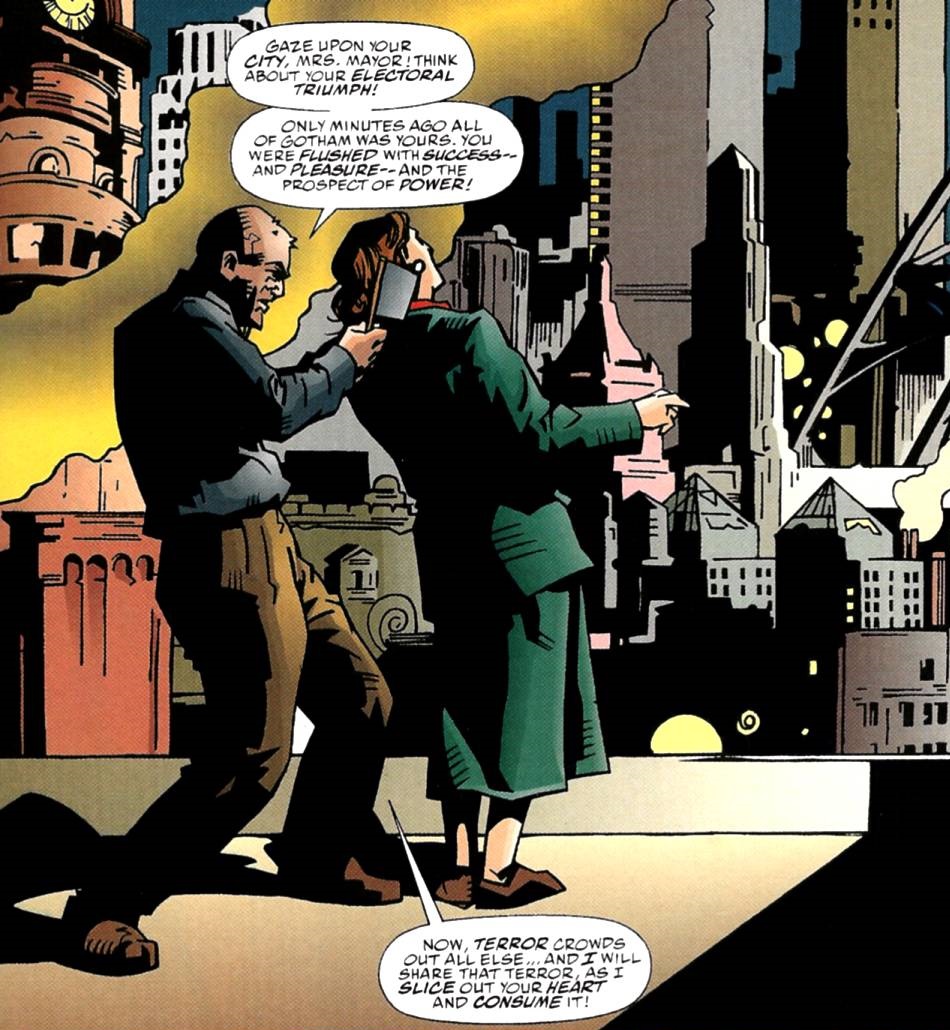For some reason, the electoral process has been on my mind. And so I turned, as I often do, to Batman comics in order to reassure myself that, as screwed up as politics appear to be at the moment in the real world, they’re still not as weird as in Gotham City.
Gotham City is my favorite Batman character. I am fascinated by the notion of a city so preposterously intense and macabre that it drives most citizens off the edge. A city where if you lose your job or your loved ones, or if you find yourself upset with the direction society is heading, you’ll decide to dress up in a colorful costume and commit themed robberies faster than Howard Beale can shout ‘I’m mad as hell, and I’m not going to take this anymore!’
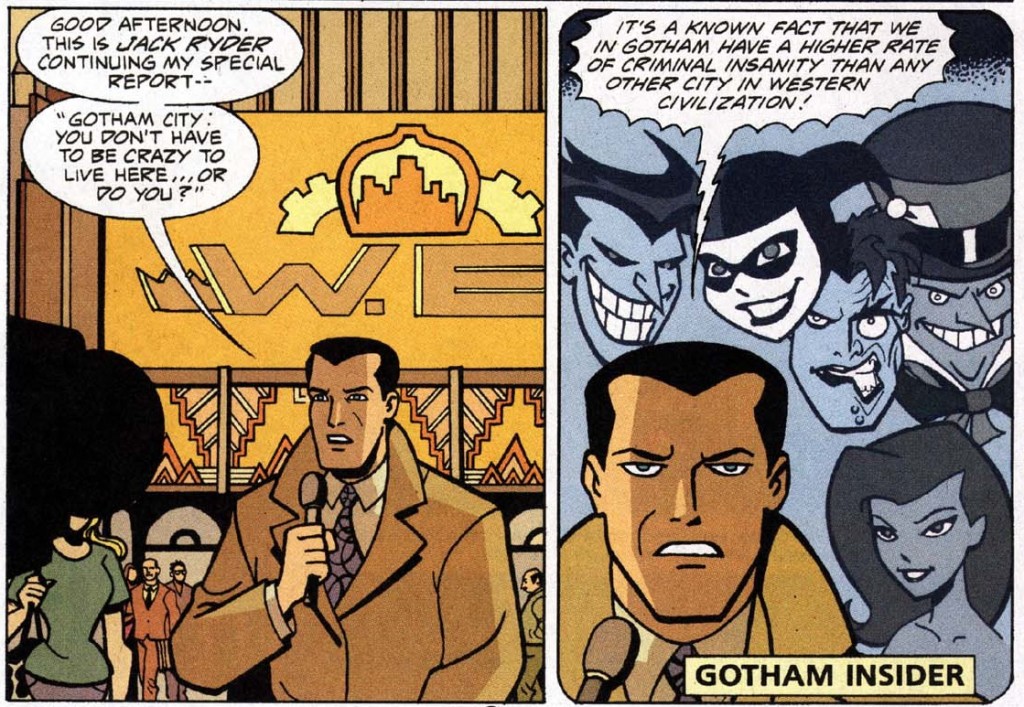 Gotham Adventures #58
Gotham Adventures #58
If we accept that the city as whole is a bit crazy, then it stands to reason that its elections would be quite off-the-wall as well. And they are. I mean, it says something that the Penguin has managed to become mayor of Gotham in at least three alternative continuities in the comics (he also came close in both a live-action movie and a TV show). And you bet your tail that one of the things Mayor Oswald Cobblepot did was to increase funding to the Novick County Bird Sanctuary by six hundred percent! (In the neat Batman Adventures (v2) #13.)
That the electoral process is corrupt goes without saying – pretty much every institution and proceeding in Gotham City are corrupt beyond New Jersey standards. From the Court of Owls to the Tobacconists’ Club led by Rupert Thorne, there is an endless tapestry of influential cabals, secret societies, and underground lobby groups pulling strings in smoke-filled rooms.

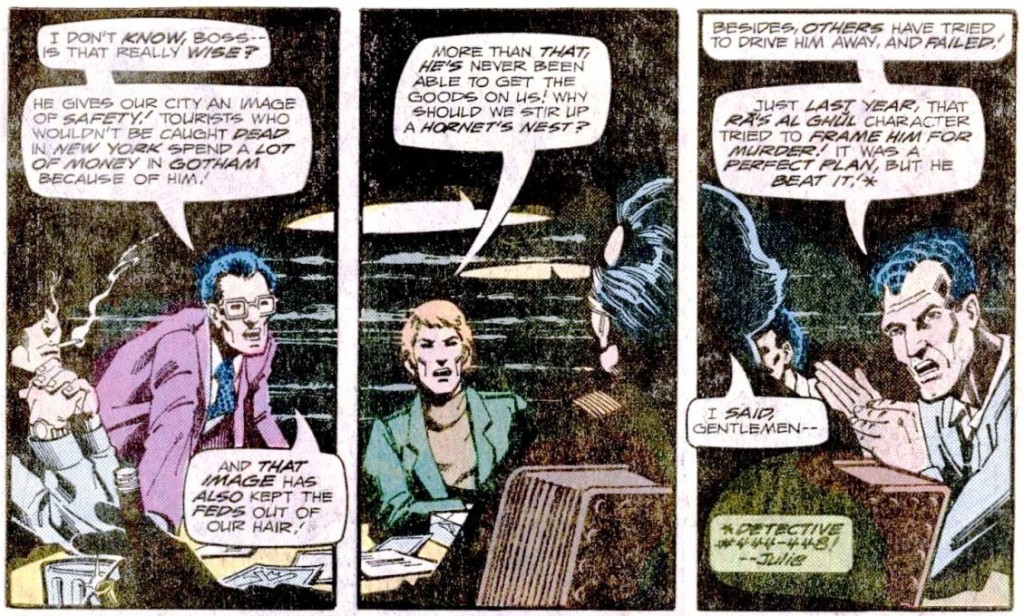 Detective Comics #471
Detective Comics #471
That said, Gotham elections still manage to reach particularly ludicrous extremes. For one thing, the people behind the campaigns tend to make Malcolm Tucker look subtle and restrained in comparison. In the 1972 mayoral election, the political bosses for the two main candidates were so dishonest that even the least dirty one tried to slander his opponent by framing him for the murder of Bruce Wayne (who was not even dead!). In a 1980 recall election for police commissioner, a campaign manager orchestrated a city-wide crime wave and ended up shooting his own candidate. Hell, even in the more kid-friendly Batman Adventures universe, elections were almost as out-of-control, as shown in ‘Decision Day’ (Batman Adventures #18), in which Batgirl and Robin found out that a major candidate had sponsored an attempt to blow up police headquarters.
(And it’s not just the local elections that can get out of hand. When Evan Gregory ran for governor in 2005, the Joker electrocuted him with a joy buzzer, kidnaped his fiancée, and finally dismembered him… In the Joker’s defense, though, the Clown Prince of Crime was running against Gregory, so this turn of events wasn’t completely unexpected. In fact, the Joker was running with the populist slogan: ‘Vote for me or I’ll kill you.’)
In terms of political debate, a recurring electoral topic concerns the fact that some local weirdo keeps disguising himself as a bat and beating up criminals with little regard for their civil rights. This used to be a pet cause of Arthur Reeves, who as the mayor’s public works commissioner spent his career demanding the Batman’s unmasking, all the way back to 1970:
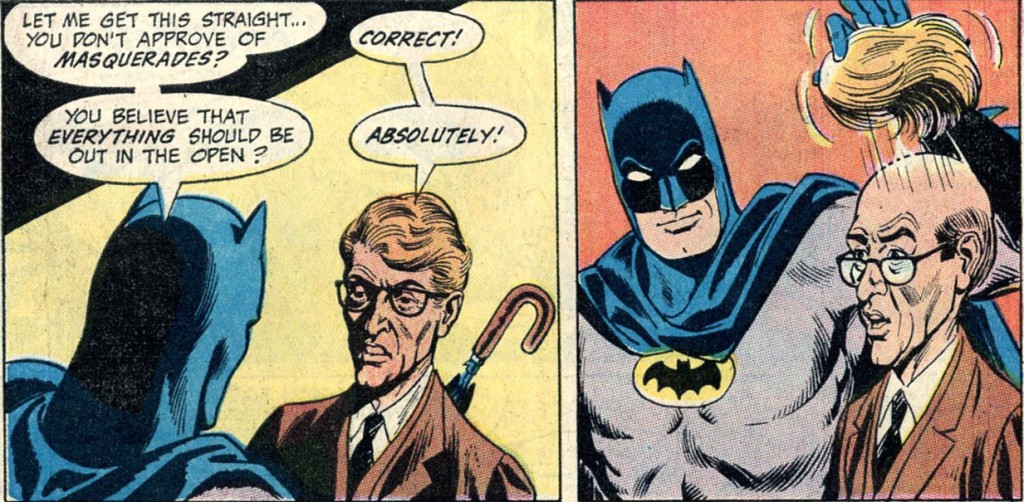 Detective Comics #399
Detective Comics #399
Reeves charged Batman with murder more than once (Batman #225, Detective Comics #419, Detective Comics #463) and for years he persistently lobbied against the police’s collaboration with the Caped Crusader:
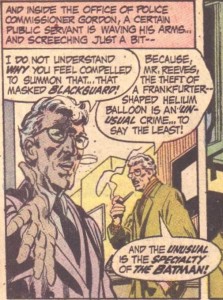 Batman #234
Batman #234
In 1981, Arthur Reeves finally ran for mayor on an anti-Batman platform, but lost against Reform Party candidate Hamilton Hill. Reeve’s campaign basically crashed and burned when he announced that he was going to expose the Dark Knight’s secret identity and gave the media photographs that supposedly showed Batman was a wanted mobster, but which were quickly proven to be forgeries. In fact, Arthur Reeves had obtained the photos from Rupert Thorne, who had framed Reeves in order to get his own man elected, i.e. Hamilton Hill.
As soon as he took office, Mayor Hill demanded the resignation of Police Commissioner James Gordon, replacing him with another Thorne stooge. Although Hamilton Hill was elected against the anti-Batman candidate, soon after the election Hill also declared war on the Dark Knight, giving the police shoot-to-kill orders. One of a long line of scumbag mayors, Hill remained in office until 1985, entangled in an expanding web of corruption and abuse of power.
A few years later, another mayoral campaign went off the rails when the short-lived villain Abattoir (who used to strip his victims’ flesh in order to eat their souls, as you do) crashed into a fund-raiser for the candidate Henry Etchison, leading to this horrific scene:

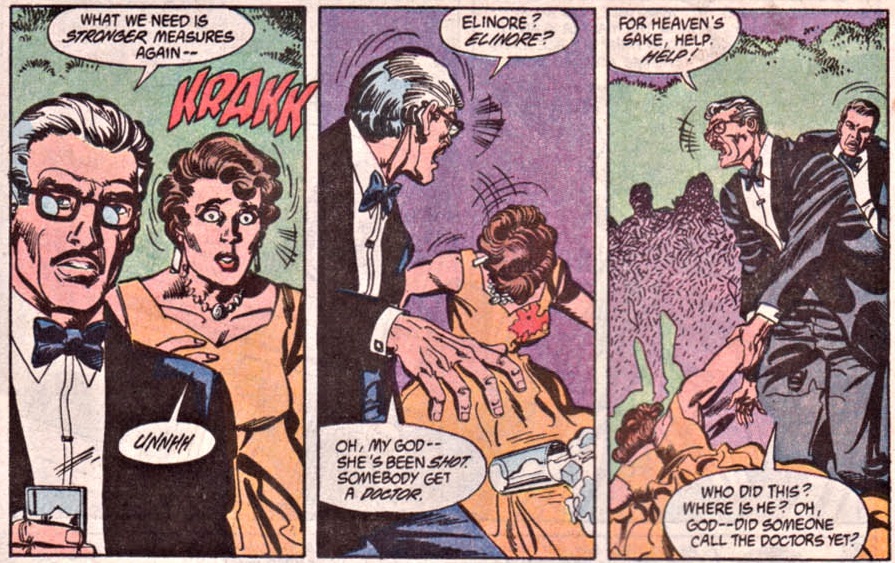 Detective Comics #625
Detective Comics #625
The most pathetic thing was that, Gotham being Gotham, it turned out Etchinson himself had released the mad killer in order to get rid of his wife Elinore, who wanted a divorce – after all, while a divorce wouldn’t be convenient in the polls, a recently murdered wife could sure help his tough-on-crime campaign!
Former District Attorney Armand Krol ran for mayor in 1992, also on a platform of law and order, invoking Batman’s crusade as proof that the police force was not doing enough by itself. He promised to keep James Gordon as commissioner, but only because of Jim’s privileged relationship with Batman. Having defeated his opponent (the corrupt judge Walter Liptic, as seen in Legends of the Dark Knight Annual #2), Krol soon got a taste of Gotham City’s mayoral life – shortly after getting elected, he was kidnapped and almost drowned by a gang of misfit villains, including Catman, Calendar Man, and Killer Moth. And not long after *that*, he was kidnapped once again, now by the Joker and the Scarecrow, who forced him to bring Gotham even closer to breaking point with a series of harmful phone calls, for example causing a firefighters’ strike and leading the police into a deadly trap!
After Batman saved him from this last stunt, Armand Krol became even more of an admirer of the Dark Knight, especially the more violent, gung ho AzBats version. Indeed, Krol decided to distance himself from the ineffectual police department and to publicly endorse Batman’s activities instead. This set the stage for my favorite Gotham City mayoral campaign in the comics.
Basically, by 1995 Krol had pissed off pretty much everyone and began to fear his chances at reelection when faced with what he called ‘the latest fad – a squeaky-clean do-gooder woman candidate,’ namely District Attorney Marion Grange. To counteract Grange’s liberal appeal, Krol replaced Commissioner Gordon with Jim’s wife, Sarah Essen. A group of businessmen then decided to back James Gordon, who agreed to run as an independent candidate but was ultimately done in over charges of police brutality.
What I love about this was that, throughout 1995, there was political maneuvering taking place on the corners of almost every Batman comic, with evolving arguments and switching endorsements, just like in any real campaign. If you bought a random issue, between all the chase scenes and panels of the Caped Crusader kicking the Scarecrow in the face, you would find all these little slices of enduring political debate:

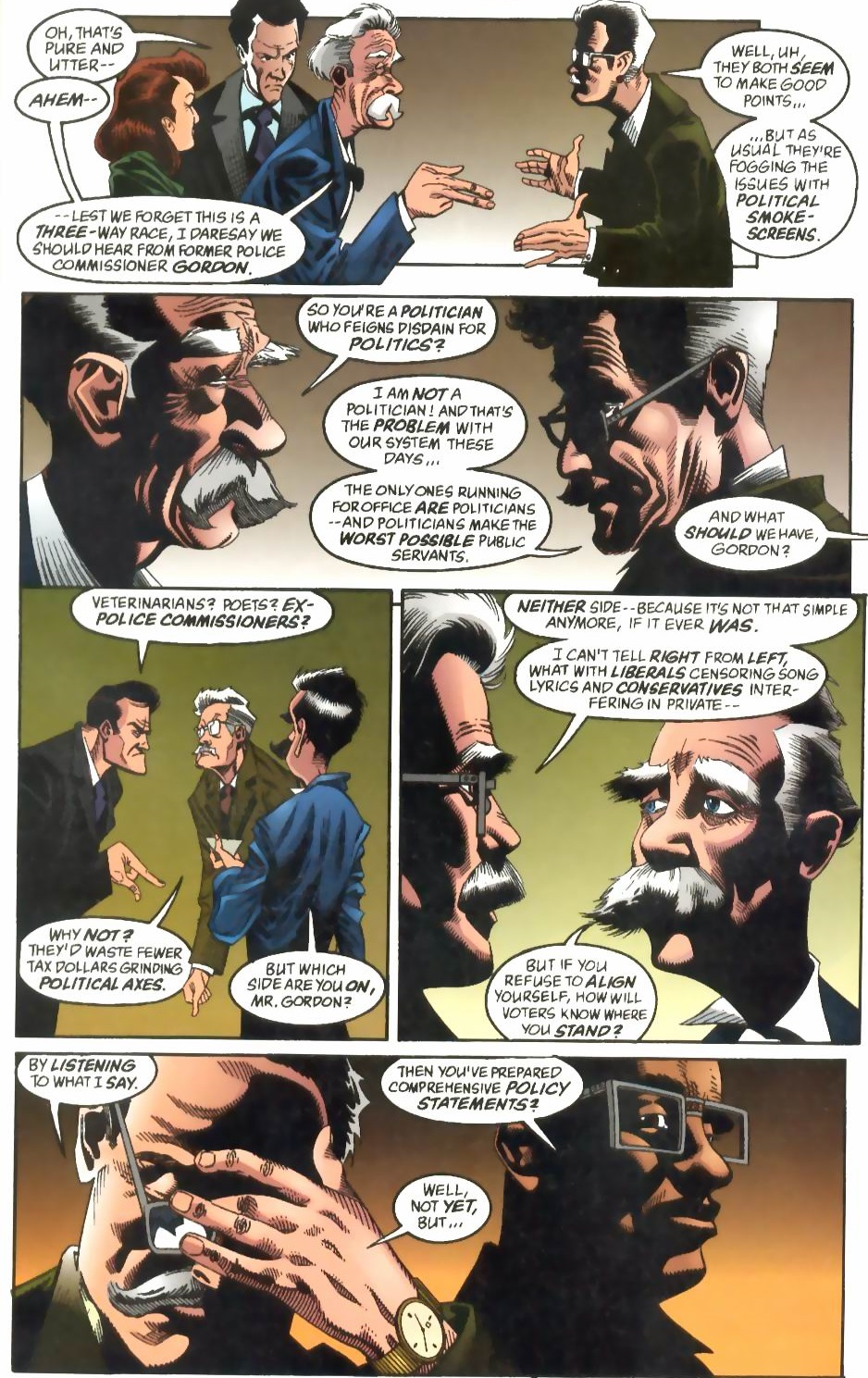 Batman #523
Batman #523
This months-long subplot culminated in one of Gotham City’s most close-run elections. After the result was announced, the ensuing chess moves and negotiations between the candidates for the roles of mayor, district attorney, and police commissioner were covered in the intertwined stories of Batman #527-528, Detective Comics #693-694, and Shadow of the Bat #46-47 (cover-dated January-March 1996).
In the end, Marion Grange managed to secure her position as the new mayor, although – needless to say – not before she got a taste of the old Gotham City welcome by getting kidnapped by a lunatic serial killer…

